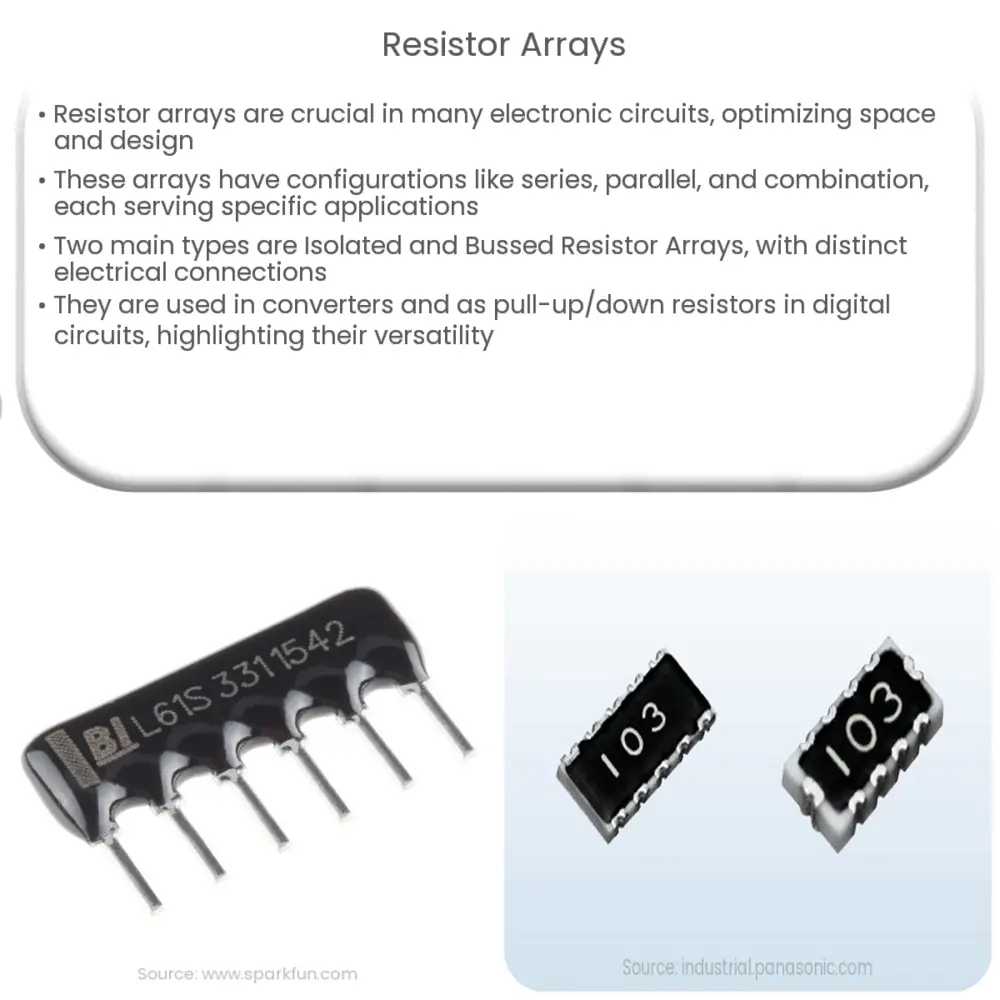Explore the world of resistor arrays, their types, applications, and importance in electronics circuit design. Learn about their versatile use in DACs, ADCs and more.

Understanding Resistor Arrays
Resistor arrays, also known as resistor networks, are an integral part of many electronic circuits. They are essentially a group of resistors that are combined and packaged inside a single case or chip, which aids in the conservation of space in circuit design.
The Structure of Resistor Arrays
A resistor array typically consists of several individual resistors connected in a specific pattern. The most common configurations are series, parallel, and combination circuits. These configurations offer different electrical properties, allowing for a wide range of applications.
- Series Configuration: In this arrangement, resistors are connected end-to-end. The total resistance in a series circuit is simply the sum of the individual resistances.
- Parallel Configuration: Resistors in a parallel configuration share both ends of their terminals with each other. In this setup, the total resistance is less than the smallest resistance in the array.
- Combination Configuration: A combination circuit contains both series and parallel configurations. The total resistance can be determined using specific rules related to the combinations of resistors.
Types of Resistor Arrays
Resistor arrays come in various forms, each with specific characteristics and applications. The two primary types are Isolated Resistor Arrays and Bussed Resistor Arrays.
- Isolated Resistor Arrays: This type of resistor array consists of individual resistors that are completely independent of each other. This implies that there is no electrical connection between the resistors, making them suitable for applications where multiple, separate voltage drops are needed.
- Bussed Resistor Arrays: Bussed resistor arrays, on the other hand, have one terminal of each resistor connected to a common bus line. This configuration is often used when a common voltage or current is required across multiple resistors.
Regardless of their type, resistor arrays play a crucial role in the world of electronics. They provide engineers and designers with an efficient way to incorporate multiple resistors into their circuits, thus optimizing both space and performance.
Applications of Resistor Arrays
Resistor arrays find their applications in a wide array of electronic systems due to their versatile characteristics. Here are some common applications:
- Digital-to-Analog Converters (DACs): DACs use resistor arrays to convert digital signals into their analog equivalents. The resistor array helps in creating the different voltage levels required for this conversion.
- Analog-to-Digital Converters (ADCs): Similar to DACs, resistor arrays are used in ADCs to create voltage reference levels needed for the conversion process.
- Pull-up or Pull-down Resistors: In digital circuits, resistor arrays are often used as pull-up or pull-down resistors, ensuring that unconnected inputs do not float and cause unpredictable results.
Resistor Array Packages
Resistor arrays are manufactured in a variety of package types, each suited to different applications and environments. These range from Dual Inline Packages (DIP) and Single Inline Packages (SIP), to the more modern Surface-Mount Device (SMD) packages. The choice of package depends on the intended use, available space, and the required durability and resistance to environmental factors.
Advantages of Using Resistor Arrays
The primary advantage of using resistor arrays is space efficiency. With multiple resistors packaged into a single component, circuit designers can save significant board space. Additionally, resistor arrays also ensure consistency as the resistors within a single array are closely matched, which helps in maintaining uniform performance across the circuit. Lastly, using resistor arrays can simplify circuit assembly and reduce manufacturing time, as they are easier to handle and install compared to individual resistors.
Conclusion
In conclusion, resistor arrays are a powerful tool in electronics, offering a compact, efficient, and consistent solution for incorporating multiple resistors into a circuit. They come in a variety of configurations, types, and packages to cater to a wide range of applications. From enabling the conversion of digital signals to analog and vice versa, to ensuring stable operation of digital circuits, resistor arrays play an indispensable role in the realm of electronic design. Understanding the functionality and application of resistor arrays is a fundamental part of electronics and circuit design.

